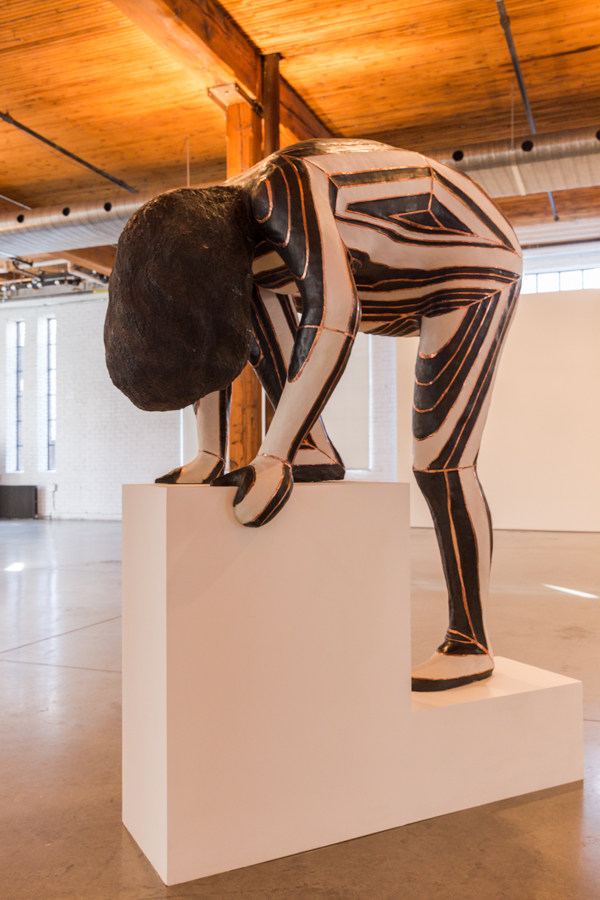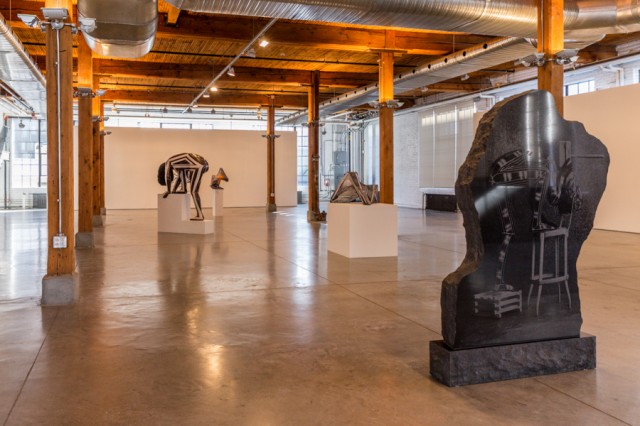Montreal-born Valérie Blass is well-known for recycling old objects into her eclectic sculptures. Her new exhibit, “Théâtre d’objets,” lives up to her reputation for innovation, spanning the three floors of Montreal’s Parisian Laundry (including its basement bunker) with sculptures and prints that simultaneously intrigue, amuse, and disturb. The exhibit is a combination of new pieces and previously displayed work from commissions at the MetroTech Center in Brooklyn. Blass plays with new technology while retaining a raw, crafted feel, with material ranging from print on granite to wooden sticks. “Théâtre d’objets” is a thought-provoking exploration of the effects of perspective and distortion on everyday objects, exposing the ability of the artist to manipulate how the objects are displayed.
Upon entry on the main floor, the first sculpture in sight is Sculpture Bidon, an upright granite slab with a laser image printed on each side. Both images feature a woman bent over with her legs propped on a stool and a chair, her body decorated with geometric forms. On one side of the granite, there is a hammer on her head. On the other, what looks like a bag sits on her back. While somewhat comical at first glance, the print seems to grow heavier the longer it is looked at, as the hammer and bag seem to weigh down this hunched, stretched woman. Sculpture Bidon introduces many integral aspects of the show, such as the prominence of angular geometric designs, the motif of the hammer, and the use of chairs as props. It is a perfect welcome to the world of Blass, featuring seemingly random inanimate objects in an absurd and humorous, yet also unsettling, way.
Many of the pieces in the show come in pairs or trios, which allows Blass to nicely demonstrate the effect of subtle differences in material or shape. Accompanying Sculpture Bidon is Orca Gladiator, a large sculpture of a female figure in the same position as the woman in Bidon. The lines on the woman’s body become stripes of white and black, lined with copper, in an almost mesmerizing array of patterns. The most striking part of the piece is the head, a giant black oval mass without features that hangs off the neck, dragging down the figure. On the same floor as these pieces is the series Portrait de pont à poutre en porte à faux, (loosely translated as “portrait of truss bridge in an awkward position”) which features the same print of a contorted truss bridge displayed in three different ways. The print is lasered onto two different, equally distorted sculptures of plaster (one in black and white, the other colour) and shown a third time as a patron, or template, broken up into pieces and mounted on a wall. Each of these installments offers a different way of further twisting the already tangled bridge: however, the pieces themselves reach such a level of distortion that it is easy to get caught in their angles. The series of prints in the basement bunker are also a study in perspective, depicting the hooded, hidden figures of puppeteers as they make shapes and scenes out of otherwise plain objects. Through these pieces Blass interestingly comments on the extent to which the puppeteers in a ‘theatre of objects’ can differently represent and warp the ordinary.
The sculptures on the second floor of the gallery, while smaller, leave a more lasting impression than the somewhat overwhelming pieces of the main floor. Prête pour le pire (“Ready for the worst”) and Se tirer dans le pied (“Shooting yourself in the foot”) are made of wooden sticks assembled into a heavy web that sits atop two long, skinny twigs, culminating in feet. The heaviness is reminiscent of the weighed-down woman in Orca Gladiator, but is more effective here, due to the fragility and simplicity of these wooden warriors. I See Your Nose Grow is another laser print on granite, an image of wooden frames with chains and a hammer set on top, oddly similar to a human body, with the handle of the hammer acting as a nose – a perfect example of Blass’ ability to create images both comedic and unsettling. The most striking piece in the exhibit makes use of this dark amusement. She’s a Nympho, I’m a Therapist is a relatively small porcelain, polystyrene, and plaster sculpture evocative of building bricks. Protruding from the bricks is a hand holding on to a coaster-sized picture of the bottom half of a woman’s body, clad only in underwear, and a gloved hand reaching forward toward her. The piece is not only the most beautiful example of the geometric contortions in Blass’ work, but also, in terms of content, has by far the most engaging and striking voice. Blass reimagines everyday objects, taking the pieces she needs to create something new, and inviting viewers to take a deeper look at seemingly ordinary objects and materials by adding unexpected layers.
The exhibit retains a commonality and cohesiveness through themes of weight, distortion, and animation of the inanimate, as well as a generally rustic and frayed aesthetic, yet each piece possesses its own individual character. Blass’ work is playfully thoughtful. While she turns ordinary objects into art, it is very much up to the public to interpret the role of the objects in her artwork. The distortions Blass creates, though sometimes overwhelmingly complex, make interesting and provocative use of shape and space. Indeed, it is sometimes the empty spaces between the sticks or shapes of the sculptures that are the most fascinating. Blass’ work with image and material distortion couples nicely with the everyday objects, such as hot dogs and hammers, the pre-existing meanings of which she incorporates into her work. The intricate yet familiar and open nature of “Théâtre d’objets” allows it to be enjoyed by many, and interpreted in many different ways. It is certainly well worth a visit to Parisian Laundry, the stage where Blass exposes her puppets and puppeteers, and invites us to get lost amongst their strings.
“Théâtre d’objets” runs until February 15 at Parisian Laundry, 3550 St. Antoine Ouest.

